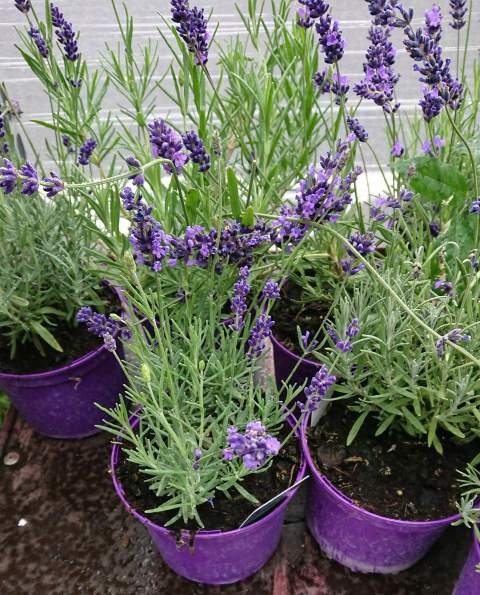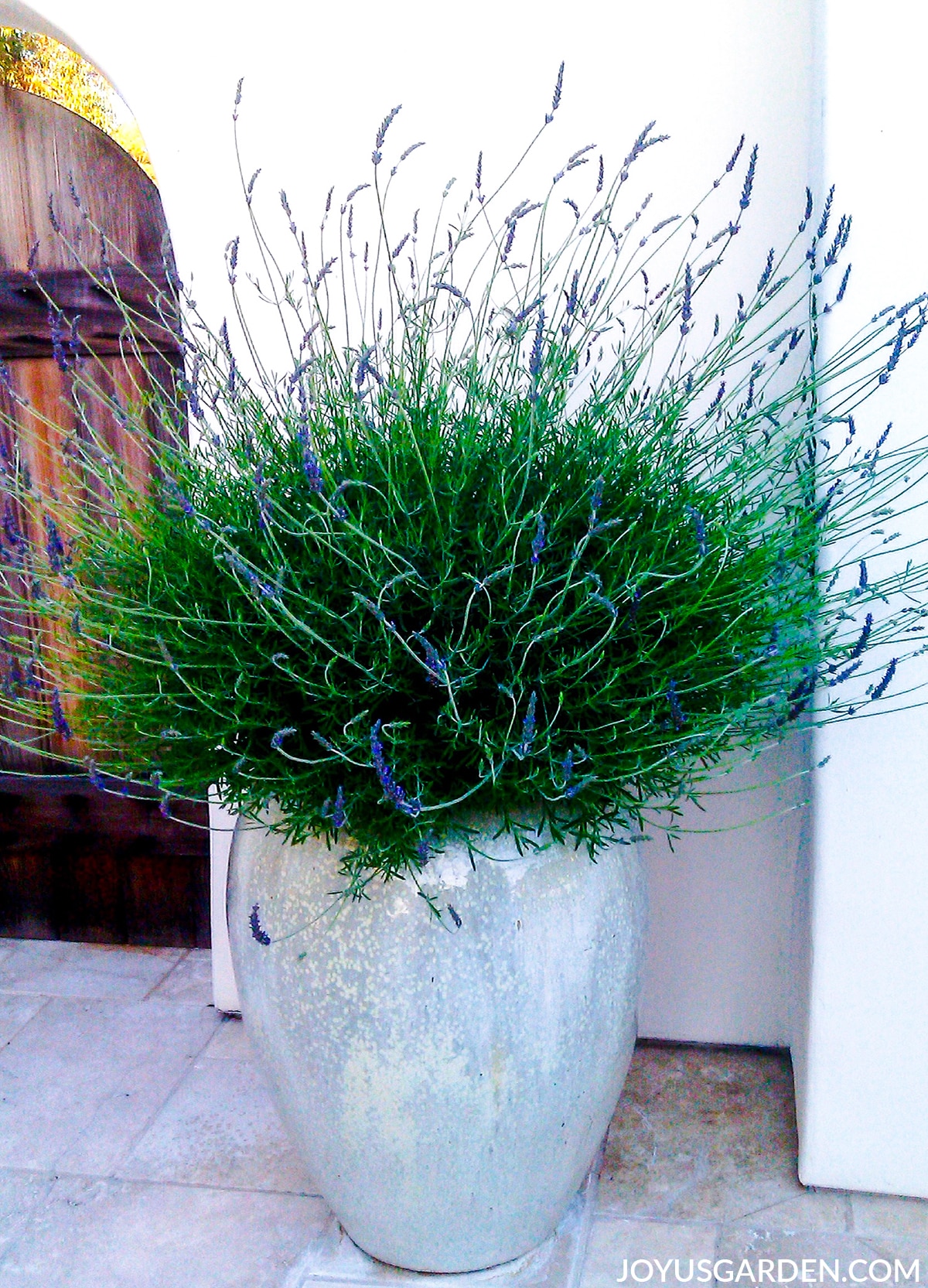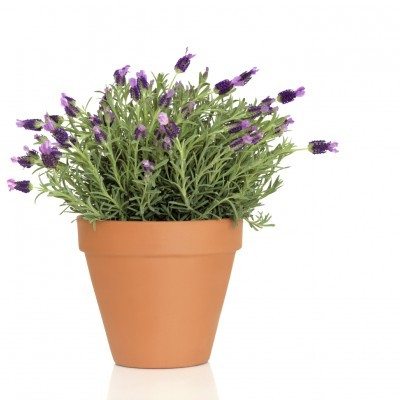Early spring is the best time of year to transplant a lavender because it will lessen transplant shock. If you modify the soil for adequate drainage and water frequently for the first season until the lavender becomes established, you can transplant lavenders in your garden or into pots.
Lavenders can, however, be transplanted at any time of the year if necessary, however doing so outside of the ideal early spring window may have a more noticeable impact on the amount of blooms that year.
The greatest time to avoid transplanting is during the winter when soils are cold and tend to retain more water, but lavender roots prefer to be kept dry.
To effectively transplant lavenders, you must:
- Make sure the soil drains rapidly; typically, sand and grit are required.
- Check the pH of the soil; lavenders appreciate a pH between 6.5 and 7.5.
- During the first year, water the lavender regularly (but not excessively) as it settles in to its new location.
- A white reflective stone mulch would be ideal to improve light exposure and thus blooming.
- Select the garden’s sunniest area (more then 6 hours of direct sun).
- To guarantee proper airflow and optimum light exposure, place the lavender at least a couple of feet away from other plants.
For detailed instructions on how to transplant lavender, keep reading. You’ll also find helpful advice on how to lessen transplant shock as your lavender gets used to its new environment.
Table of Contents
Choose a Sunny, Dry Location for Transplanting
Lavenders need at least six hours of sunlight each day, but full sun is recommended for optimum results.
A lavender plant will blossom and generate less of the oil that gives it its scent as well as becoming leaner and untidy the less sunshine it receives. Full shadow is incompatible with the Mediterranean conditions that the lavender prefers, thus it will simply not be able to survive.
Additionally, the lavender’s roots, foliage, and soil are kept dry by the full light, which makes it less vulnerable to fungus.
The lavender will benefit from transplanting to a pot since you may move it to the sunniest spot and it will be dryer than if you planted it in the ground, which will aid the roots.
Avoid planting lavender in any low-lying or wet garden areas that frequently experience natural moisture retention or persistent moisture after rain.
As opposed to beds with soggy soil, planting lavender on raised beds, pots, or on mounds or rockeries will all give better drainage conditions for the plants.
Lavender plants should be spaced 2 to 3 feet apart to allow air to circulate through the foliage, which will lower humidity and deter fungus.
Dig your Hole and Amend the Soil
The ideal environment for growing lavender is sandy, low-fertility soil that drains well and mimics the Mediterranean region where it naturally occurs.
The lavender will probably develop root rot and the soil might be overly fertile if you transplant it into clay soils or rich organic soil that retains moisture (high fertility soils encourage foliage growth at the expense of producing blooms).
30% sand (or grit) to 70% soil is the optimal ratio for soil. Sand will help the soil maintain the proper structure so that water may drain as efficiently as possible away from the roots.
Grit and sand also don’t add many nutrients to the soil, so they’ll balance out rich soils and allow the lavender to grow a healthy bloom.
The lavender’s root system will fit in the hole you are excavating or the pot you are using when it is fully established if it is at least 18 inches deep and 16 inches wide.
The more soil you can amend with sand to prevent water from simply draining away from the 18 inches of amended soil and pooling or draining too slowly from the clay soil beneath, the better if you are planting lavender in soil that tends to retain water (clay soils, for example).
With a spade or a tiller, thoroughly incorporate the sand and grit into the soil and check that the sand is distributed evenly.
Sand is less effective than gravel at creating the proper drainage structure in soils with some clay concentration.
You can move planted lavender into a pot with 30% sand and 70% potting soil or well-draining soil. To allow extra water to drain, the base of the pot must include drainage holes.
the pH of your soil. You can plant lavender in your yard if the pH of the soil is between 6.5 and 7.5. Since most organic matter will be around pH 7 after being fully decomposed, most garden soil falls within this range (neutral).
However, you can get a cheap soil test kit from Amazon or a garden supply store if you are concerned.
It is quite simple to do soil tests, you can use them repeatedly, and they cost a fraction of what multiple lavender plants would. To bring your soil’s pH up to the ideal level if it is too acidic (below pH 6.5), you can apply some agricultural lime or wood ash.
Lift the Lavender out of the Soil with a Fork
When moving lavenders, I always advise using a garden fork because it is far less likely to cut through roots than a spade or shovel, which are much more indiscriminate.
To prevent transplant shock, gently work your fork around the outside of your lavender plant and coax it out, lifting it out with as much soil as you can (unless it is already planted in clay soil which is unsuitable).
Super Tip. Prior to digging, wet the soil with a watering can to assist the soil to hold together more tightly around the roots. The less likely the plant is to experience transplant shock, the more of the original soil that was kept in a framework surrounding the roots can be transferred with the lavender.
When lavender is transplanted into a new location, it experiences transplant shock, a period of adjustment. A lavender plant that has had transplant shock may develop slowly, not blossom the next year, or possibly die. However, this is highly improbable with the right care.
Fill the new hole with soil, then plant the lavender there.
To give the lavender plant some support, compact the dirt around it by hand. Be careful not to use too much force, though, as roots find it difficult to grow in such soils.
top advice Commercial lavender producers frequently employ a white stone or gravel mulch around the base of the plants. This will prevent weed growth, assist in reflecting sunlight back onto the plant, keep the foliage dry (reducing the risk of illness), and promote the growth and production of stunning lavender blossoms.
Water Lavender once per week after transplant (Let Soil Dry Between Watering)
After planting, give the lavender a good bath with lots of water so that it may get used to its new environment.
Because they are accustomed to the hot, dry regions of southern Europe, lavenders are drought-tolerant plants that prosper on infrequent watering. They are much more likely to suffer from overwatering than from a lack of water.
A newly transplanted lavender, however, will require more care and attention until the following season, when it becomes more established.
| Lavender Age of Transplant | Watering Guidelines |
| immediately following lavender transplantation. | After transplanting, give the lavender a good soak, preferably first thing in the morning. Never water leaves or woody stems; always water the plant’s base. |
| within the initial four weeks following transplant. | After transplanting, soak the surrounding soil once a week for the first four weeks. |
| four weeks later. | If there has been a substantial amount of rain, cut back on watering to once every two weeks and avoid watering altogether. |
| potted lavender plants | Even if there has been some rainfall, lavender plants transplanted into pots still need to be in full sun and watered every two weeks because pots can dry up in hot weather. |
| Long-standing Lavender (1 year after transplant). | Because of their great drought resistance, established lavender plants frequently may not require any additional water at all. In exceptionally hot and dry weather, just water once every two weeks. |
Avoiding overwatering is the most crucial tip when it comes to caring for lavender plants. Lavender will seem droopy and its foliage may turn brown, which is a sign of root rot, if it receives too much water. Read this post for the answer if your lavender exhibits any of these symptoms of stress.
Because containers can heat up on hot days, quickly drying them out, and because the root system is typically more exposed than it would be if it were planted, watering transplanted lavenders in pots requires additional attention.
However, because containers offer the best drainage, transplanted lavenders frequently thrive there. For a detailed guide, see my post on watering lavender plants in containers.
Watering at night typically attracts pests like slugs, which do not target lavender but may attack other plants in your yard. Always water at the base of the plant, and it is best practice to water in the morning as it will charge the plant with water in the coming day.
The lavender will become established a year after transplanting, and you will only need to water it during dry spells.
(Read my post on growing lavender in containers.)
Additional Transplanting Tips
- Avoid fertilizing your lavender with organic or chemical fertilizers because they will encourage the growth of foliage instead of flowers. In the Mediterranean region of Europe, lavenders grow best in low fertility, sandy soils; rich soils heavy in nutrients will result in a leggy appearance or yellow leaves, which indicates that there is too much nitrogen in the soil for optimum lavender growing conditions.
- The perfect mulch for transplanted lavenders is made of white reflective stones, wood bark, or stone. Avoid using organic material that retains moisture, such as leaf mold or grass clippings, since these may encourage the damp conditions that can cause your lavender plant to die from root rot.
Summary of How to Transplant Lavender
- If at all possible, transplant lavenders in the early spring when they are just coming out of their winter hibernation and less likely to experience transplant shock than if done in the middle of the growing season.
- When transplanting lavenders, pick a sunny area of your yard because they thrive in direct sunlight.
- To increase drainage, first prepare the transplant location or pot by adding lots of sand or gravel to the soil.
- Plant the lavender and level the area but avoid compacting the soil.
- After planting, water thoroughly right away, then once a week for the following few weeks.
- Reduce watering to once every two weeks after four weeks and only water if there hasn’t been any rain.
Check out my comprehensive guide, which covers everything from winter care to pruning guidelines, if you’ve transplanted your lavender into a pot. It will help you obtain the best growth and bloom from potted lavenders.
Check out my article on how to dye lavenders if your lavender is looking sick.
https://www.youtube.com/watch?v=I0sZyUkNzyQ/hqdefault.jpg?sqp=-oaymwEcCOADEI4CSFXyq4qpAw4IARUAAIhCGAFwAcABBg==\u0026rs=AOn4CLBD7RVpzCc3iaDQOZaEG9RHsP8_pg”,”width”:480,”height”:270}]},”title”:{“runs”:[{“text”:”How to Transplant Lavender Plants”}],”accessibility”:{“accessibilityData”:{“label”:”How to Transplant Lavender Plants by Joybilee 4 years ago 4 minutes, 5 seconds 21,004 views”}}},”longBylineText”:{“runs”:[{“text”:”Joybilee”,”navigationEndpoint”:{“clickTrackingParams”:”CLsCENwwGAAiEwjg1rety4H6AhW-nMIBHbxHAEw=”,”commandMetadata”:{“webCommandMetadata”:{“url”:”/c/JoybileeFarm”,”webPageType”:”WEB_PAGE_TYPE_CHANNEL”,”rootVe”:3611,”apiUrl”:”/youtubei/v1/browse”}},”browseEndpoint”:{“browseId”:”UC1H-UhxQ3LQVtcMt7zRmJkg”,”canonicalBaseUrl”:”/c/JoybileeFarm”}}}]},”publishedTimeText”:{“simpleText”:”4 years ago”},”lengthText”:{“accessibility”:{“accessibilityData”:{“label”:”4 minutes, 5 seconds”}},”simpleText”:”4:05″},”viewCountText”:{“simpleText”:”21,004 views”},”navigationEndpoint”:{“clickTrackingParams”:”CLsCENwwGAAiEwjg1rety4H6AhW-nMIBHbxHAEwyBnNlYXJjaFIScmVwb3R0aW5nIGxhdmVuZGVymgEDEPQk”,”commandMetadata”:{“webCommandMetadata”:{“url”:”/watch?v=I0sZyUkNzyQ”,”webPageType”:”WEB_PAGE_TYPE_WATCH”,”rootVe”:3832}},”watchEndpoint”:{“videoId”:”I0sZyUkNzyQ”,”params”:”qgMScmVwb3R0aW5nIGxhdmVuZGVyugMLCIvMyfOJye-2tQG6AwsI7_vn9tT6nbS9AboDCwjjgoKGuqi61soBugMLCOOA0J3On6y1ywG6AwoIvays3uPlsM8qugMLCMDP5dnzp-bCxQG6AwoIoLe5_piV0P8QugMLCKjnmu_XgoDo4AG6AwoIovuhzeP235BrugMKCLa8y5CKv4KzCLoDCwib7urfkre8l7IBugMKCMzcm76J59WtT7oDCgithNnx55K5-nW6AwsIlc37wsDQ0tSNAboDCwjmkpGwt-nRn9ABugMLCOq3_5KE7KOlhAG6AwsI9obe8OuA2tOcAboDCgipz9iI0-_exnm6AwsIkZ7XnpmIsI76AQ%3D%3D”,”watchEndpointSupportedOnesieConfig”:{“html5PlaybackOnesieConfig”:{“commonConfig”:{“url”:”https://rr5—sn-qxoednee.googlevideo.com/initplayback?source=youtube\u0026orc=1\u0026oeis=1\u0026c=WEB\u0026oad=3200\u0026ovd=3200\u0026oaad=11000\u0026oavd=11000\u0026ocs=700\u0026oewis=1\u0026oputc=1\u0026ofpcc=1\u0026rbqsm=fr\u0026msp=1\u0026odeak=1\u0026odepv=1\u0026osfc=1\u0026id=234b19c9490dcf24\u0026ip=172.56.15.150\u0026initcwndbps=245000\u0026mt=1662515822\u0026oweuc=”}}}}},”ownerText”:{“runs”:[{“text”:”Joybilee”,”navigationEndpoint”:{“clickTrackingParams”:”CLsCENwwGAAiEwjg1rety4H6AhW-nMIBHbxHAEw=”,”commandMetadata”:{“webCommandMetadata”:{“url”:”/c/JoybileeFarm”,”webPageType”:”WEB_PAGE_TYPE_CHANNEL”,”rootVe”:3611,”apiUrl”:”/youtubei/v1/browse”}},”browseEndpoint”:{“browseId”:”UC1H-UhxQ3LQVtcMt7zRmJkg”,”canonicalBaseUrl”:”/c/JoybileeFarm”}}}]},”shortBylineText”:{“runs”:[{“text”:”Joybilee”,”navigationEndpoint”:{“clickTrackingParams”:”CLsCENwwGAAiEwjg1rety4H6AhW-nMIBHbxHAEw=”,”commandMetadata”:{“webCommandMetadata”:{“url”:”/c/JoybileeFarm”,”webPageType”:”WEB_PAGE_TYPE_CHANNEL”,”rootVe”:3611,”apiUrl”:”/youtubei/v1/browse”}},”browseEndpoint”:{“browseId”:”UC1H-UhxQ3LQVtcMt7zRmJkg”,”canonicalBaseUrl”:”/c/JoybileeFarm”}}}]},”trackingParams”:”CLsCENwwGAAiEwjg1rety4H6AhW-nMIBHbxHAExApJ63yJS5xqUj”,”showActionMenu”:false,”shortViewCountText”:{“accessibility”:{“accessibilityData”:{“label”:”21K views”}},”simpleText”:”21K views”},”menu”:{“menuRenderer”:{“items”:[{“menuServiceItemRenderer”:{“text”:{“runs”:[{“text”:”Add to queue”}]},”icon”:{“iconType”:”ADD_TO_QUEUE_TAIL”},”serviceEndpoint”:{“clickTrackingParams”:”CL4CEP6YBBgLIhMI4Na3rcuB-gIVvpzCAR28RwBM”,”commandMetadata”:{“webCommandMetadata”:{“sendPost”:true}},”signalServiceEndpoint”:{“signal”:”CLIENT_SIGNAL”,”actions”:[{“clickTrackingParams”:”CL4CEP6YBBgLIhMI4Na3rcuB-gIVvpzCAR28RwBM”,”addToPlaylistCommand”:{“openMiniplayer”:true,”videoId”:”I0sZyUkNzyQ”,”listType”:”PLAYLIST_EDIT_LIST_TYPE_QUEUE”,”onCreateListCommand”:{“clickTrackingParams”:”CL4CEP6YBBgLIhMI4Na3rcuB-gIVvpzCAR28RwBM”,”commandMetadata”:{“webCommandMetadata”:{“sendPost”:true,”apiUrl”:”/youtubei/v1/playlist/create”}},”createPlaylistServiceEndpoint”:{“videoIds”:[“I0sZyUkNzyQ”],”params”:”CAQ%3D”}},”videoIds”:[“I0sZyUkNzyQ”]}}]}},”trackingParams”:”CL4CEP6YBBgLIhMI4Na3rcuB-gIVvpzCAR28RwBM”}}],”trackingParams”:”CLsCENwwGAAiEwjg1rety4H6AhW-nMIBHbxHAEw=”,”accessibility”:{“accessibilityData”:{“label”:”Action menu”}}}},”channelThumbnailSupportedRenderers”:{“channelThumbnailWithLinkRenderer”:{“thumbnail”:{“thumbnails”:[{“url”:”https://yt3.ggpht.com/w3KarTxvEF_3OztFl_AoD98r4YkaKyD6dxvFQQALhPdhG8hda5zLtOre3rkK_S8YSpSu839mFQ=s68-c-k-c0x00ffffff-no-rj”,”width”:68,”height”:68}]},”navigationEndpoint”:{“clickTrackingParams”:”CLsCENwwGAAiEwjg1rety4H6AhW-nMIBHbxHAEw=”,”commandMetadata”:{“webCommandMetadata”:{“url”:”/c/JoybileeFarm”,”webPageType”:”WEB_PAGE_TYPE_CHANNEL”,”rootVe”:3611,”apiUrl”:”/youtubei/v1/browse”}},”browseEndpoint”:{“browseId”:”UC1H-UhxQ3LQVtcMt7zRmJkg”,”canonicalBaseUrl”:”/c/JoybileeFarm”}},”accessibility”:{“accessibilityData”:{“label”:”Go to channel”}}}},”thumbnailOverlays”:[{“thumbnailOverlayTimeStatusRenderer”:{“text”:{“accessibility”:{“accessibilityData”:{“label”:”4 minutes, 5 seconds”}},”simpleText”:”4:05″},”style”:”DEFAULT”}},{“thumbnailOverlayToggleButtonRenderer”:{“isToggled”:false,”untoggledIcon”:{“iconType”:”WATCH_LATER”},”toggledIcon”:{“iconType”:”CHECK”},”untoggledTooltip”:”Watch later”,”toggledTooltip”:”Added”,”untoggledServiceEndpoint”:{“clickTrackingParams”:”CL0CEPnnAxgBIhMI4Na3rcuB-gIVvpzCAR28RwBM”,”commandMetadata”:{“webCommandMetadata”:{“sendPost”:true,”apiUrl”:”/youtubei/v1/browse/edit_playlist”}},”playlistEditEndpoint”:{“playlistId”:”WL”,”actions”:[{“addedVideoId”:”I0sZyUkNzyQ”,”action”:”ACTION_ADD_VIDEO”}]}},”toggledServiceEndpoint”:{“clickTrackingParams”:”CL0CEPnnAxgBIhMI4Na3rcuB-gIVvpzCAR28RwBM”,”commandMetadata”:{“webCommandMetadata”:{“sendPost”:true,”apiUrl”:”/youtubei/v1/browse/edit_playlist”}},”playlistEditEndpoint”:{“playlistId”:”WL”,”actions”:[{“action”:”ACTION_REMOVE_VIDEO_BY_VIDEO_ID”,”removedVideoId”:”I0sZyUkNzyQ”}]}},”untoggledAccessibility”:{“accessibilityData”:{“label”:”Watch later”}},”toggledAccessibility”:{“accessibilityData”:{“label”:”Added”}},”trackingParams”:”CL0CEPnnAxgBIhMI4Na3rcuB-gIVvpzCAR28RwBM”}},{“thumbnailOverlayToggleButtonRenderer”:{“untoggledIcon”:{“iconType”:”ADD_TO_QUEUE_TAIL”},”toggledIcon”:{“iconType”:”PLAYLIST_ADD_CHECK”},”untoggledTooltip”:”Add to queue”,”toggledTooltip”:”Added”,”untoggledServiceEndpoint”:{“clickTrackingParams”:”CLwCEMfsBBgCIhMI4Na3rcuB-gIVvpzCAR28RwBM”,”commandMetadata”:{“webCommandMetadata”:{“sendPost”:true}},”signalServiceEndpoint”:{“signal”:”CLIENT_SIGNAL”,”actions”:[{“clickTrackingParams”:”CLwCEMfsBBgCIhMI4Na3rcuB-gIVvpzCAR28RwBM”,”addToPlaylistCommand”:{“openMiniplayer”:true,”videoId”:”I0sZyUkNzyQ”,”listType”:”PLAYLIST_EDIT_LIST_TYPE_QUEUE”,”onCreateListCommand”:{“clickTrackingParams”:”CLwCEMfsBBgCIhMI4Na3rcuB-gIVvpzCAR28RwBM”,”commandMetadata”:{“webCommandMetadata”:{“sendPost”:true,”apiUrl”:”/youtubei/v1/playlist/create”}},”createPlaylistServiceEndpoint”:{“videoIds”:[“I0sZyUkNzyQ”],”params”:”CAQ%3D”}},”videoIds”:[“I0sZyUkNzyQ”]}}]}},”untoggledAccessibility”:{“accessibilityData”:{“label”:”Add to queue”}},”toggledAccessibility”:{“accessibilityData”:{“label”:”Added”}},”trackingParams”:”CLwCEMfsBBgCIhMI4Na3rcuB-gIVvpzCAR28RwBM”}},{“thumbnailOverlayNowPlayingRenderer”:{“text”:{“runs”:[{“text”:”Now playing”}]}}}],”richThumbnail”:{“movingThumbnailRenderer”:{“movingThumbnailDetails”:{“thumbnails”:[{“url”:”https://i.ytimg.com/an_webp/I0sZyUkNzyQ/mqdefault_6s.webp?du=3000\u0026sqp=CIjS35gG\u0026rs=AOn4CLADF9GpwqorGE43f8n6qknCkgWk0Q”,”width”:320,”height”:180}],”logAsMovingThumbnail”:true},”enableHoveredLogging”:true,”enableOverlay”:true}},”detailedMetadataSnippets”:[{“snippetText”:{“runs”:[{“text”:”Lavender”,”bold”:true},{“text”:” is a little tricky to grow successfully in colder areas. Starting with larger nursery plants is helpful as larger plants are less …”}]},”snippetHoverText”:{“runs”:[{“text”:”From the video description”}]},”maxOneLine”:false}],”searchVideoResultEntityKey”:”EgtJMHNaeVVrTnp5USDnAigB”}},{“videoRenderer”:{“videoId”:”tW2-SJ5yZgs”,”thumbnail”:{“thumbnails”:[{“url”:”https://i.ytimg.com/vi/tW2-SJ5yZgs
FAQ
How do you repot potted lavender?
Plant Lavender Every Year Slide the lavender out of the container once a year in late winter or early spring, and repot it with new potting soil. Use the identical pot or a little broader pot. Every year when you repot your plants, add a slow-release general-purpose fertilizer to provide nutrients for the upcoming growing season.
How do you transplant potted lavender?
When lavender gets established, it can withstand drought. Use a Fiskars® garden shovel to prepare a hole large enough to accommodate the lavender plant’s extensive root system before transplanting it. Use a Fiskars transplanter to gently loosen the soil in the pot, then gently knock the plant out of its pot. Plant the roots widely around your garden.
What kind of soil does potted lavender need?
Lavender should be grown on soil that is well-drained, slightly alkaline, and between pH 6.7 and 7.3. Before planting, you can add builder’s sand to the soil to improve drainage. This is important because lavender won’t tolerate a lot of soil wetness or humidity.
Does lavender like to be root bound?
Lavender plants grown in pots prefer a slightly alkaline pH of the soil. Note: It’s wise to avoid compacting the soil too firmly when planting because this could lead to issues in the future. Lavender plants in pots may get “root bound,” which can restrict growth and stress the plant.



